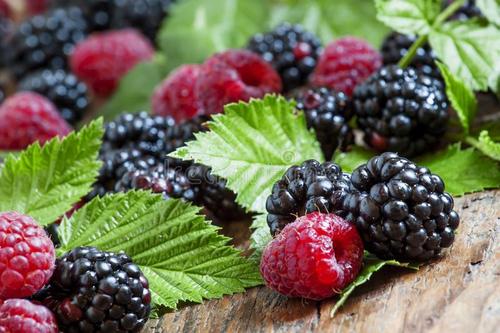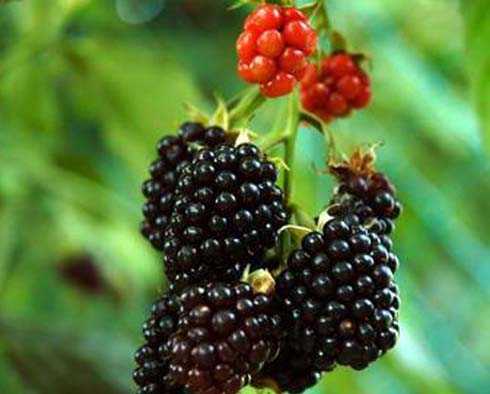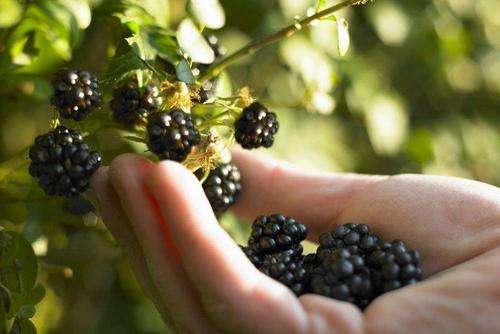Blackberry Profile
Written by Maggie
Apr 08 2023

Blackberry is a perennial vine of Rosaceae. Since ancient Greece more than two thousand years ago, local people have formed the custom of eating wild Blackberry with thorns. Blackberry is the representative variety of the third generation of fruit that is popular all over the world in recent years.
Blackberry Picture

Morphological Characteristics of Blackberry
The Blackberry tree is a widely distributed and well-known shrub; Plants of the raspberry family, usually biennial, having erect, semi-erect, or climbing stems and thorns, sometimes without thorns in cultivated species. Blackberry can grow up to three meters tall and produce soft fruit - often used in desserts, jams, seedless jellies and sometimes in fruit wines. Leaves for three or palmate compound leaves, there are three to five leaflets, leaflets wide, elliptic, stalk, leaf margin coarse tooth crack, most leaves persistent overwintering. Flowers of Blackberry white or pink, fruit aggregates, black or reddish-purple drupes borne on the juicy receptacle. Read More: Boysenberry vs. Blackberry - Are They The Same Thing
The Geographical Distribution of Blackberry
Blackberry is native to the northern temperate zone of the old and new continents, especially in eastern North America and the Pacific coast, in the British Isles and Western Europe as a common copse and hedge plants.
Blackberry Growth Habit
Blackberry has high requirements for planting land and the environment. The soil moisture and fertility should be moderate. The growth of Blackberry has the habit of creeping upward, and the arched stem has short and curved but sharp thorns. When the bent, drooping branches touch the ground, they will sprout roots from the knobs at the top of the branches. This characteristic, coupled with the fast growth rate of Blackberry, allows Blackberry growing in woodlands, shrubs and hillsides to spread out and take up a large area of land in a very short time.

Blackberry Function
1. Enhance immunity. Blackberries contain twice as much vitamin C as blueberries. Vitamin C performs a number of important functions in the body, helping to strengthen the immune system, maintain cardiovascular health, reduce high blood pressure, improve the body's absorption of iron from the diet, and reduce the risk of anemia.
2. Aids digestion. Blackberries contain more fiber than most other fruits. A handful of blackberries contains 8 grams of fiber, more than two cups of wheat, which helps better meet your daily requirement of 25 grams of fiber. Fiber is extremely important for digestive tract health, helping to maintain a healthy weight and reduce high cholesterol.
3. Heal wounds. Blackberries are rich in tannins. Sarah Wilson, the chief nutritionist at the Princess Grace Hospital in London, says blackberries help tighten skin tissue, constrict blood vessels and reduce blood loss. In traditional medicine, blackberries are used as a wound-healing medicine.
4. Cancer. Blackberries are rich in the antioxidant anthocyanins. It has been found that anthocyanins can inhibit the growth of tumor cells. Blackberries also contain a flavonoid called C3G, which is effective against skin cancer and lung cancer.

Latest Updated
- Blackberry Profile
- Blackberry Lily (Iris Domestica) Profile
- How to Propagate Blackberry
- How to Prune Cilantro - Should I Cut Them After It Flowers?
- How to Grow Cilantro?
- Boysenberry vs. Blackberry - Are They The Same Thing
- Can Java Moss Grow Out Of Water - How to Make It Possible
- How Fast Does Java Moss Grow - How to Make It Grow Fast
- How to Grow & Care for Java Moss
- How to Remove Moss from Your Roof - Quick & Safe Methods
Popular Articles
- Winter maintenance of Antirrhinum Majus
- How to Grow Terminalia Mantaly Tree
- How to Grow and Care for Crossostephium Chinense
- How to grow Antirrhinum Majus in spring
- Peristeria Elata (Dove Orchid) Profile: Info & Care Guide
- How to Care for Brazilian Jasmine Plant (Mandevilla Sanderi)
- Underwatered Snake Plant (Sansevieria Trifasciata) - Signs And How To Fix
- Rosa Chinensis (China Rose): Plant Growing & Care Tips
- How to Grow & Care for Graptopetalum Purple Delight in Summer
- How to Care for Baby Sun Rose (Aptenia Cordifolia)